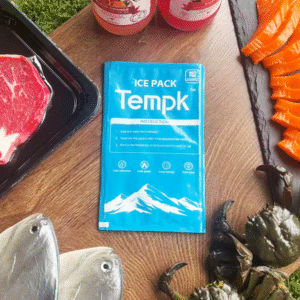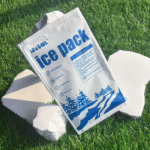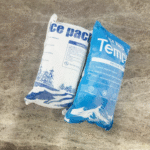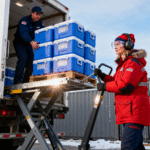Ultra Cold Chain Logistics: Why It Matters and How to Optimize It in 2025
The global ultra cold chain — the system that keeps biological and frozen goods at extreme low temperatures — is rapidly evolving. Di dalam 2025 new gene and cell therapies, mRNA vaccines and premium foods demand reliable ultra low temperatures, while regulation and sustainability goals reshape operations. This guide answers what the ultra cold chain is, why it matters to you, and how to optimize it. Ultra cold chain appears in the first paragraph to anchor the main keyword.

What is the ultra cold chain and how does it differ from standard cold chain logistics? (includes long tail keywords like ultra low temperature logistics and cryogenic storage)
Which market trends will shape ultra cold chain logistics in 2025? (covers automation, ketertelusuran digital, demand growth and sustainability)
How can you overcome challenges such as energy usage, packaging and regulation? (integrates long tail keywords like cold chain packaging solutions and GDP compliance)
What practical steps can businesses take to optimize ultra cold chain operations? (discusses IoT sensors, renewable energy and predictive analytics)
FAQ: Answers to common questions about ultra cold chain equipment, temperature ranges and regulatory requirements.
What Is the Ultra Cold Chain and How Is It Different?
The ultra cold chain keeps products at ultra low temperatures like −20 °C, −40 °C or −80 °C to preserve sensitive goods such as biologics, gene therapies and mRNA vaccines. Standard cold chains maintain refrigerated (2–8 ° C.) atau dibekukan (−18°C) kondisi, but the ultra cold chain operates at far lower temperatures to protect delicate biological structures. Biologics account for more than 40 % of newly approved drugs in 2024, and about 20 % of therapies in development are gene or cell based. These treatments degrade rapidly at higher temperatures and require specialized freezers, es kering, and cryogenic containers.
Compared with a conventional cold chain, the ultra cold chain requires:
Peralatan khusus: Ultra low freezers capable of −70 °C or even cryogenic liquid nitrogen (−196°C) penyimpanan. Dry ice and phase change materials maintain temperatures during transport.
Multi temperature zones: Modern warehouses often include zones for 2–8 °C, −20 ° C., −80 °C and cryogenic storage to handle diverse pharmaceuticals and specimens.
Redundant power and monitoring: Continuous power supply, backup generators and real time temperature and humidity monitoring to prevent costly losses.
Compliance with strict regulations: Praktek Distribusi yang Baik (PDB), Amerika Serikat. Undang-Undang Modernisasi Keamanan Pangan (FSMA) and WHO guidelines require validated processes and documentation. FSMA 204 aturan, effective in 2026, mandates end to end traceability for many perishable foods.
Risk based packaging: Wadah terisolasi, Paket gel, vacuum insulated panels and active containers help maintain ultra low temperatures during long journeys.
Dengan kata lain, the ultra cold chain is a specialized extension of cold chain logistics designed to protect high value biopharmaceuticals, research samples and premium foods where even small temperature deviations can cause irreversible damage.
Temperature Ranges and Applications
| Kisaran suhu | Produk Khas | Relevance to You |
| 2–8 ° C. (Didinginkan) | vaksin, insulin, susu | Most common cold chain range; used when goods need to stay chilled but not frozen |
| −18 to −25 °C (Beku) | daging, hidangan laut, beberapa obat-obatan | Standard frozen range; mainstream cold chain logistics |
| −40 to −80 °C (Sangat rendah) | Vaksin mRNA, Biologi, terapi gen | Requires special freezers and dry ice; prevents molecular degradation |
| Kriogenik (<−150 °C) | stem cells, CAR T therapies, biobanking | Stored in liquid nitrogen; extremely sensitive products |
Practical Tips for Handling Ultra Cold Goods
Qualify your equipment: Use validated freezers and packaging tested under worst case scenarios. Consider backup units and remote monitoring for fail safe operations.
Rencanakan rute Anda: Pre determine transit times, required temperature hold times and contingency steps in case of delays. Real time tracking allows you to intervene before a shipment fails.
Latih tim Anda: Personnel must understand how to handle dry ice safely and how to read data loggers. Proper training reduces the risk of accidents and ensures compliance.
Contoh dunia nyata: During the global COVID 19 vaccine rollout, ultra cold distribution networks had to deliver millions of doses kept at −70 °C. One pharmaceutical company invested in modular ultra low freezers, insulated shipping boxes with temperature loggers and GPS trackers. This approach reduced spoilage, ensured regulatory compliance and helped meet vaccination timelines.
Market Landscape and Growth Trends in 2025
The ultra cold chain market is expanding rapidly due to innovations in biotechnology, rising demand for high value foods and stricter regulatory requirements. Understanding market dynamics helps you identify opportunities and prepare for change.
Global Market Size and Growth
| Indikator | Nilai | Arti Praktis |
| Cold chain market value (2023) | ≈ $293.58 billion | The broader cold chain logistics sector, encompassing refrigerated and frozen goods, is already a substantial industry |
| Projected 2032 nilai | $862.33 billion | Expected compound annual growth rate (CAGR) ≈ 13 % means major expansion |
| Penelitian Prioritas 2025 estimate | $436.3 billion | Illustrates how quickly the market grows from 2024–2025 |
| Food cold chain market 2035 | $1.63 trillion | Food remains the largest cold chain segment; implies opportunities for ultra low freeze for premium foods |
| Ultra low segment growth rate | ≈ 8.5 % CAGR | Reflects increasing adoption of ultra cold storage for biologics |
| APAC region CAGR | ≈ 14.3 % | Asia Pacific is the fastest growing market, driven by healthcare and food exports |
These figures show that the cold chain market is on a steep growth trajectory. The rising share of biologics and cell therapies, coupled with expansion in Asia, underscores the need for more ultra low capacity and resilient infrastructure.
Drivers of Growth
Biopharmaceutical innovation: Over 20 % of drugs in development involve gene or cell therapies, and more than 40 % of new approvals are biologics. These products require ultra low storage conditions.
Vaccine programs: mRNA vaccines must be stored at −70 to −80 °C. Future vaccine technologies may also require similar conditions.
Regulatory demands: FSMA 204 rule in the U.S. mandates digital traceability for many food products, increasing demand for technology solutions and validated processes.
Tekanan keberlanjutan: Cold chain operations contribute roughly 2 % of global carbon emissions, prompting pressure to cut energy use and emissions.
Harapan konsumen: E commerce and home delivery of fresh foods require consistent temperature control, raising the bar for reliability.
Emerging Trends to Watch in 2025
Smart automation and robotics: Saat ini, tentang 80 % gudang tidak otomatis. Companies are adopting automated storage and retrieval systems (ASRS), robotic palletizers and autonomous mobile robots to improve accuracy and safety.
Real time monitoring and IoT: Sensor IoT, telematics and cloud platforms provide continuous visibility. Telematics can reduce product loss by up to 30 % and enable predictive maintenance.
Green logistics: Renewable power sources, biofuels and energy efficient refrigerants help reduce emissions. Itu Move to −15 °C initiative proposes raising the standard frozen temperature from −18 °C to −15 °C, which could save 17.7 million tonnes of CO₂, 25 TWh energi and reduce costs by 5 12 %.
AI dan analisis prediktif: Artificial intelligence analyses data to optimize routes, predict equipment failures and minimize energy use.
Built to suit facilities: Outsourcing to specialized cold storage providers that design multi temperature warehouses with redundant systems becomes more common.
Challenges and Risks in Ultra Cold Logistics
Despite growth, the ultra cold chain faces significant challenges. Understanding these obstacles helps you plan mitigation strategies.
High Energy Consumption and Sustainability
Operating ultra low freezers demands significant energy. Cold chain facilities account for roughly 2 % emisi CO₂ global. Selain itu, food waste along the cold chain generates an estimated 8–10 % of greenhouse gas emissions. Utilities costs are rising, and governments are imposing stricter efficiency standards.
What you can do:
Upgrade to modern freezers with better insulation and variable speed compressors.
Implement energy management systems that track consumption by zone and time of day.
Participate in industry initiatives like Move to −15 °C to reduce energy usage while maintaining product quality.
Explore renewable energy options such as rooftop solar and on site battery storage.
Infrastructure Limitations and Capacity Constraints
Many regions lack sufficient ultra cold warehouses and transportation equipment. The supply of dry ice can also be strained during surges in demand, as seen during pandemic vaccine distribution. The industry is working to build more capacity through built to suit facilities and outsourcing. Lebih-lebih lagi, driver shortages and limited skilled workforce challenge reliability.
What you can do:
Partner with third party logistics providers specializing in ultra cold storage.
Invest in training programs to develop a skilled workforce capable of handling complex cold chain tasks.
Consider co locating manufacturing and storage facilities to reduce transportation time and risk.
Complex Regulations and Compliance
The ultra cold chain must comply with multiple regulations such as GDP, FSMA, WHO guidelines and local health authorities. FSMA 204 requires collecting key data elements and sharing them within 24 hours of a request. Failure to meet these obligations can result in fines and reputational damage.
What you can do:
Implement digital traceability systems that log temperature, location and chain of custody information for each shipment.
Conduct regular audits and qualification of equipment, processes and suppliers to demonstrate compliance.
Provide comprehensive training so staff understand how to document and handle regulated goods.
Packaging and Transportation Risks
Maintaining ultra low temperatures during transit is challenging. Kemasan pasif (MISALNYA., Paket gel, wadah terisolasi) may not hold extreme temperatures for more than a few days. Active containers with electrical or battery powered refrigeration can extend hold times but are expensive. Dry ice sublimation can create carbon dioxide build up if not vented properly.
What you can do:
Choose packaging based on trip duration and ambient conditions. Untuk perjalanan panjang, consider active containers or cryogenic dry ice boxes.
Use real time temperature loggers and GPS trackers to monitor shipments. Alerts allow you to intervene if temperatures drift.
Establish contingency plans for delays, including pre arranged replenishment points for dry ice.
Talent and Workforce Challenges
Operating ultra cold chain facilities requires specialized skills, from handling cryogenic materials to maintaining sophisticated sensors. Many businesses face a shortage of qualified staff.
What you can do:
Create educational partnerships with vocational schools and universities.
Develop career pathways that attract younger talent to cold chain logistics.
Automate repetitive tasks to improve efficiency and allow staff to focus on higher level responsibilities.
2025 Developments and Future Outlook
Untuk tetap kompetitif, businesses must anticipate and adapt to upcoming innovations. Inilah yang diharapkan 2025 dan seterusnya.
Technology Highlights
| Inovasi | Dampak | Practical Value |
| Digital twin systems | Simulate warehouses and transportation routes virtually to test different scenarios | Allows you to optimize temperature control and energy usage before implementing physical changes |
| Predictive maintenance with AI | Uses machine learning to predict equipment failures | Reduces downtime and prevents product loss by replacing components before they fail |
| Automated high density storage | Robotic shuttles store pallets in extremely cold environments | Increases capacity without expanding footprint and reduces worker exposure to extreme conditions |
| Ketertelusuran Blockchain | Creates tamper proof records of temperature and custody data | Enhances trust and compliance with FSMA 204 and similar regulations |
| Multi temperate packaging systems | Hybrid containers maintain different zones within the same unit | Supports shipments that include items requiring 2–8 °C and −80 °C simultaneously |
Inisiatif Keberlanjutan
Major cold chain operators are committing to net zero targets. Realizing these goals involves:
Energy efficiency upgrades: Meningkatkan isolasi, switching to low global warming potential refrigerants and adopting natural refrigerants.
Renewable energy integration: Installing solar arrays on warehouse roofs and using energy storage to offset peak demand.
Pengoptimalan rute: AI driven algorithms reduce travel distance and idle time, cutting fuel consumption.
Product waste reduction: Enhanced forecasting, dynamic pricing and donation programs reduce food waste and associated emissions.
Collaborative platforms: Sharing warehouse space and transport capacity increases utilization and reduces duplication.
Regulatory Evolution
Regulatory oversight will tighten as governments prioritize food safety and pharmaceutical integrity. FSMA 204 rule becomes enforceable in 2026 and extends digital traceability requirements beyond the U.S. Many other countries are considering similar legislation. Businesses should prepare by standardizing data formats and participating in industry forums to shape best practices.
Market Predictions
Analysts forecast continued double digit growth in cold chain logistics. The proliferation of personalized medicine, expansion of e commerce, and heightened food safety requirements will fuel demand. Sementara itu, competition will intensify, especially in Asia Pacific, as new entrants build capacity. Companies that invest in technology, sustainability and resilience will gain an edge.
How to Optimize Your Ultra Cold Chain Operations
Here are practical steps you can take now to strengthen your ultra cold chain and improve performance.
Petakan rantai pasokan Anda: Identify every touchpoint from manufacturing to final delivery. Understand where temperature deviations are most likely and install monitoring devices accordingly.
Implement IoT and real time visibility: Use sensors that transmit temperature, data kelembaban dan lokasi. Alerts enable proactive intervention and support compliance.
Automate data collection and reporting: Integrate your monitoring systems with enterprise resource planning (ERP) and quality management systems. Automate compliance reports to satisfy FSMA 204 and GDP requirements.
Invest in energy efficient infrastructure: Replace outdated equipment with ultra low freezers that have better insulation and refrigerants. Consider phase change materials and vacuum insulation panels for packaging.
Evaluate green logistics options: Participate in the Move to −15 °C initiative where feasible, use renewable energy and optimize routes to cut fuel consumption.
Build strategic partnerships: Outsource to specialized providers when internal capacity is insufficient. Joint ventures or shared cold storage can reduce costs and provide access to advanced technology.
Develop a skilled workforce: Provide continuous training on handling ultra cold materials, safety procedures and regulatory requirements. Offer incentives to attract and retain talent.
Plan for contingency: Create risk management plans for power outages, dry ice shortages and transportation delays. Keep backup systems and redundancy across your network.
Pertanyaan yang sering diajukan
What temperatures define the ultra cold chain?
Ultra cold chain refers to maintaining goods at −40 °C to −80 °C or even cryogenic temperatures below −150 °C. Standard cold chain ranges are 2–8 °C (didinginkan) and −18 °C to −25 °C (beku).
Why are gene and cell therapies so sensitive?
Gene and cell therapies contain living cells or viral vectors that degrade quickly when temperatures rise. Maintaining ultra low temperatures preserves their potency until they reach patients.
How long can dry ice keep shipments cold?
Es kering menyublim seiring waktu. Dalam wadah yang terisolasi dengan baik, it may maintain ultra low temperatures for 2–4 days. Untuk perjalanan yang lebih lama, you may need to replenish dry ice or use active refrigeration.
What are the main regulations affecting the ultra cold chain?
Peraturan utama mencakup Praktik Distribusi yang Baik (PDB), Undang-Undang Modernisasi Keamanan Pangan (FSMA), FSMA 204 traceability rule and guidelines from the World Health Organization. Compliance requires documented processes, traceability and validated equipment.
How can companies reduce energy consumption in ultra cold storage?
Companies can switch to energy efficient equipment, optimize freezer usage, implement demand response programs, integrate renewable energy and participate in initiatives like the Move to −15 °C.
Ringkasan dan Rekomendasi
Itu ultra cold chain is a specialized extension of cold chain logistics designed to keep biologics, terapi gen, vaccines and premium foods at temperatures far below freezing. Demand is surging due to the growth of biologics (over 40 % of new drugs), terapi gen (20 % of pipeline products) and mRNA vaccines requiring −70 °C storage. The market is expected to grow rapidly, with global cold chain logistics projected to reach $862 miliar oleh 2032. Pada saat yang sama, the sector faces challenges related to energy consumption, kemasan, regulatory compliance and workforce shortages.
To succeed in 2025 dan seterusnya, companies should invest in ultra low freezers, adopt IoT based monitoring, automate warehouse processes and embrace sustainability initiatives such as the Move to −15 °C, which could reduce emissions by 17.7 juta ton and save 25 TWh of energy. Building strategic partnerships, training staff and leveraging predictive analytics will further improve resilience and efficiency. Dengan menerapkan strategi tersebut, you can ensure that temperature sensitive goods arrive safely, mematuhi peraturan yang berkembang, and meet consumer expectations.
Tentang tempk
Tempk is a leading provider of cold chain solutions with expertise in ultra cold logistics. We design and operate multi temperature warehouses that include 2–8 °C, −20 °C and −80 °C zones, along with cryogenic storage for biologics. Our systems use IoT sensors and advanced analytics to ensure real time visibility and compliance with GDP and FSMA requirements. Kami berkomitmen terhadap keberlanjutan, incorporating renewable energy and energy efficient equipment into our facilities. Whether you need to store mRNA vaccines, gene therapies or gourmet foods, Kami provide flexible, secure and environmentally responsible solutions.
Panggilan untuk bertindak: Contact our experts to explore how Tempk can help you optimize your ultra cold chain. From feasibility studies and warehouse design to end to end transportation and regulatory compliance, we offer tailored services for your specific needs.























